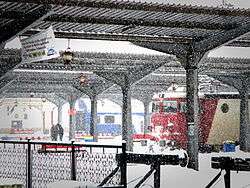Bucharest North railway station
București Gara de Nord | |||||||||||||||||||||||||||||||||||||||||||||||||||||||||||||||||
|---|---|---|---|---|---|---|---|---|---|---|---|---|---|---|---|---|---|---|---|---|---|---|---|---|---|---|---|---|---|---|---|---|---|---|---|---|---|---|---|---|---|---|---|---|---|---|---|---|---|---|---|---|---|---|---|---|---|---|---|---|---|---|---|---|---|
| Căile Ferate Române | |||||||||||||||||||||||||||||||||||||||||||||||||||||||||||||||||
|
| |||||||||||||||||||||||||||||||||||||||||||||||||||||||||||||||||
| Location | Piața Gării de Nord, Bucharest, Romania | ||||||||||||||||||||||||||||||||||||||||||||||||||||||||||||||||
| Coordinates | 44°26′46.92″N 26°4′27.15″E / 44.4463667°N 26.0742083°ECoordinates: 44°26′46.92″N 26°4′27.15″E / 44.4463667°N 26.0742083°E | ||||||||||||||||||||||||||||||||||||||||||||||||||||||||||||||||
| Owned by | CFR | ||||||||||||||||||||||||||||||||||||||||||||||||||||||||||||||||
| Line(s) |
Bucharest-Constanța Bucharest-Craiova Bucharest-Ploiești Bucharest-Pitești Bucharest-Ruse Bucharest-Urziceni M1 Line (Bucharest Metro) M4 Line (Bucharest Metro) | ||||||||||||||||||||||||||||||||||||||||||||||||||||||||||||||||
| Platforms | 8 | ||||||||||||||||||||||||||||||||||||||||||||||||||||||||||||||||
| Tracks | 14 | ||||||||||||||||||||||||||||||||||||||||||||||||||||||||||||||||
| Construction | |||||||||||||||||||||||||||||||||||||||||||||||||||||||||||||||||
| Structure type | terminal station | ||||||||||||||||||||||||||||||||||||||||||||||||||||||||||||||||
| Parking | yes | ||||||||||||||||||||||||||||||||||||||||||||||||||||||||||||||||
| History | |||||||||||||||||||||||||||||||||||||||||||||||||||||||||||||||||
| Opened | 1872 | ||||||||||||||||||||||||||||||||||||||||||||||||||||||||||||||||
| Electrified | yes (16 February 1969) | ||||||||||||||||||||||||||||||||||||||||||||||||||||||||||||||||
| Services | |||||||||||||||||||||||||||||||||||||||||||||||||||||||||||||||||
| |||||||||||||||||||||||||||||||||||||||||||||||||||||||||||||||||
Bucharest North railway station (Romanian: București Gara de Nord) is the main railway station in Bucharest and the largest railway station in Romania. The vast majority of mainline trains to and from Bucharest originate from Gara de Nord.
History
The station was built between 1868-1872, the foundation stone was set on 10 September 1868 in the presence of Carol I of Romania. The building is designed as a U-shaped structure. The first railways between Roman - Galați - Bucharest - Pitești were put in service on 13 September 1872. Between 1895-1896 a new wing of the station was built, which included a "Royal hall" due to the visit of Emperor Franz Joseph of Austria-Hungary.[1] It was initially named Gara Târgoviștei, after the road nearby, Calea Târgoviștei ("Târgoviște Road", nowadays Calea Griviței) and took its current name in 1888.
The station and its surroundings were heavily bombed by the Allies in April 1944 during a campaign aimed at the Axis supply lines, since the station played an important part in the Romanian railway network and was the main departure point for troops headed to the Eastern Front.
Under communist times, the station received a number of upgrades, such as a footbridge (1950s or 1960s), partial electrification on 16 February 1969, and then a expansion between 1978 and 1984 and complete electrification. It is still upgraded as of today, having received a platform overhaul (replacement of tiles with asphalt from 2006 to 2010), removal of the footbridge (replaced with Basarab Overpass in 2009) and, in 2018, removal of the original split-flap displays with LED ones.
Current status

There are currently 14 tracks and 8 platforms.
As of 2009, Gara de Nord served about 200 trains, including domestic trains operated by Căile Ferate Române, Regiotrans and Trans Feroviar calatori as well international trains to Hungary - Budapest, Bulgaria - Sofia, Varna and Burgas, Republic of Moldova - Chișinău, Ukraine - Kiev, Dnipro and Chernivtsi, Austria - Vienna, Turkey - Istanbul, Russia - Moscow and Saratov, Belarus - Minsk.
The station is served by several bus ( lines 105, 123,133,178,182,205,282 and express line 780 which links the railway station with the Henry Coandă Airport) trolleybus (65, 79 and 86 on Grivița side and 62,85,93,96 on The Columnes side) and tram lines (42,45,46 on Grivița side and 44 on Dinicu Golescu side), as well as the Gara de Nord metro station. Also, the station is connected by CFR train to Henri Coandă International Airport.
See also
References
External links

- Trains timetable
- Station North Bucharest
- Trains timetable
